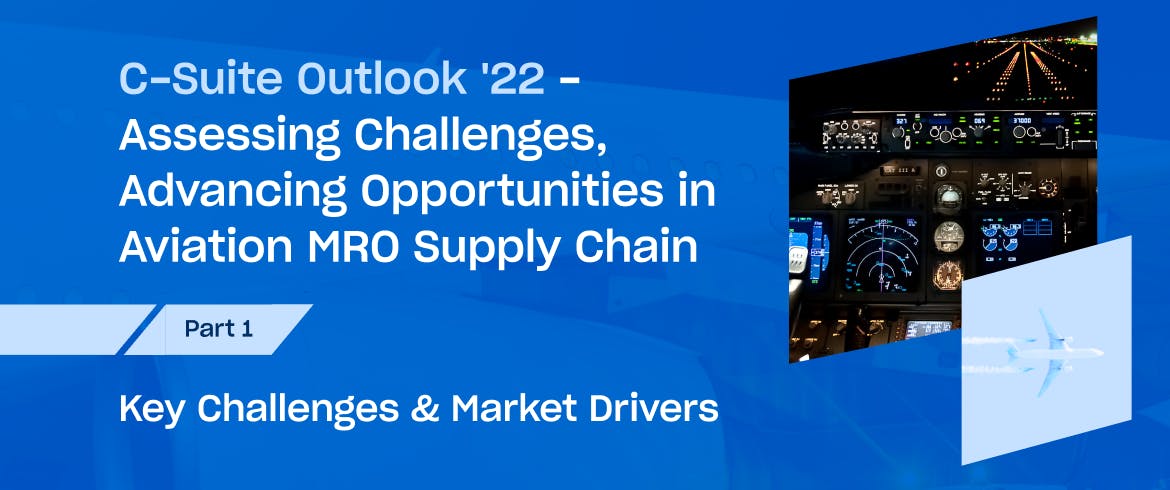
C-Suite Outlook '22 - Assessing Challenges, Advancing Opportunities in Aviation MRO Supply Chain.
Who better to hear from than those with the eagle-eye view from the top? That’s why we recently held a webinar featuring C-level executives, which dove into the MRO supply chain. If you missed out on the webinar, no worries! You can re-watch it and get the abridged version right here.
In this first part, we’ll give you the highlights from the topics of challenges and market drivers.
The Biggest MRO Challenges
Right now, not just aviation but the entire world is faced with rising inflation and an impending recession, which will force individuals and companies alike to control costs. This will undoubtedly spill over to airline MRO functions, which have already been massively affected by the demand shock over the last few years.
"The world is worried about how year-on-year pricing is increasing," said Iván Vallejo González, Director of Strategy and Supply Chain at Iberia. "In aviation, we've seen this for the last couple of decades. And basically, every ten years costs double up, whilst revenues for airlines go down 2-3%."
With so much change, supply change visibility becomes very important. As Patrick Coval, Innovation & Product Development Design, SkyThread, and former Managing Director - Tech Ops Supply Chain at United Airlines put it, “You can drive down a straight road with your eyes closed, but if you are going to encounter turns and swings, the more aware you are, the better.”
When supply chain transparency is discussed, most of the time, the topic is supply. The other half of the equation is "demand", and suppliers need to be aware of this. Knowing changes in demand as soon as possible allows suppliers to take smarter actions. Slow down production, not stop it altogether.
As things that could result from a pandemic or recession worsen, suppliers who tend to be very small businesses begin to respond very quickly. Small suppliers live from cash flow. Therefore, when orders are exhausted, they react quickly to stop bleeding. That means letting go of qualified people. As we saw as a result of Covid, many will not return.
Beyond visibility, another significant challenge is long lead times. A significant contributor to the long lead times is the amount of manual activities and redundancies in the order management and delivery processes.
“When a part takes 15 minutes to be received into inventory instead of 2 minutes, it’s a problem,” said Coval. “You might say that 13 minutes is not going to cause problems, but when you realize that this 15-minute part is behind 50 other 15-minute parts, now you're pushing 12 hours to receive the last part.”
Much of this time goes to manual, non-value-added work, and beyond inefficiencies, manual work also leads to errors, which only compounds problems. Errors contribute so much to delays and excess demand in the supply chain that are avoiding them is reason enough to digitize every order and shipment.
What’s Driving the MRO Market?
As for looking into market developments, there are several key indicators that we can look towards. Over the next 10 years, information will be one of the biggest drivers in the MRO market. Information is relatively cheap compared to expensive machines and inventories, and the lead time to move to better information is relatively short and impactful.
As we have seen in other industries, speed, the ability to provide services and goods in response, in this case, aerospace components quickly distinguish between winners and losers. The key to responding quickly and getting ready is good information.
“The sooner you know, the more prepared you are for what's to come. As always, MRO vendors are under pressure from both customers and suppliers,” said Coval. “Most of this bottleneck is due to cost and price, but at the root of it is information, specifically the reliability of that information.”
The MRO needs to be very careful about the inputs it receives in order to provide the repair and overhaul services that airlines need, even with detailed parts, services, and even complex sub-assemblies. In addition to the part pedigree, the MRO needs to know the status of the parts already ordered and the availability of parts that may be needed for repairs appearing in the workshop.
"This traditionally requires heavy investment capital, which creates a lot of parts sitting on shelves," said Gonzàlez. "We've seen technology change this in other industries by creating a share of assets. Airbnb is a great example of being the largest hospitality provider in the world but owning zero assets. Uber is another example. Why can't this happen in MRO."
Additionally, OEMs and third-party PMAs are one of the most exciting things that have happened in aerospace and many industries over the last three decades, including 3D printing and, more specifically, additive manufacturing.
Additive Manufacturing, as it means, takes the opposite route of historic casting and forging, milling, and machining, basically creating new parts from raw metal powder. A few expensive parts are the best environment for laminated molding.
A supplier who has used this to move to a just-in-time or Kanban approach, making available a wide variety of inventories with very short lead times, will be the supplier to work with in the future, creating the most reliable supply chain. And, of course, fast and reliable communication with them is an advantage for MROs, so going back to information!
What makes all of this work is digitization. Providing customers with the digital information they need is easier than printing all the documents provided in the past.
“Investing in technology or information is way cheaper than buying parts or machines and all of that kind of stuff,” said Coval.

This on-demand video recording explores MRO supply chain challenges, market drivers, and growth strategies.
